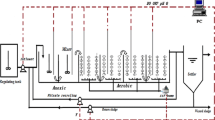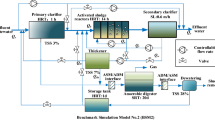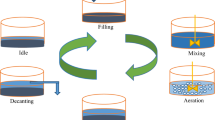Abstract
Anaerobic-anoxic-oxic (A2O) reactors, as the core parts of wastewater treatment process (WWTP), have attracted considerable attention to achieve the reliability of denitrification and dephosphorization. However, it is difficult to realize the optimal operation of A2O reactors due to the existence of nonlinear dynamics and large uncertainties. To solve this problem, a robust optimal control (ROC) strategy is developed to improve the operation performance of A2O reactors. First, data-driven systematic evaluation criteria are developed to describe the operational indicators of changeable conditions. Second, a robust optimization algorithm is designed to select the optimal solution. Third, a fuzzy neural network (FNN) is used to track the optimal solution in the control process. Finally, this proposed ROC strategy is applied to the phosphorus removal benchmark simulation model (BSM1-P) and the real A2O reactors. The results demonstrate that the strategy developed in this paper has great potential for application in real A2O reactors.
Similar content being viewed by others
References
Boiocchi R, Mauricio-Iglesias M, Vangsgaard A K, et al. Aeration control by monitoring the microbiological activity using fuzzy logic diagnosis and control. Application to a complete autotrophic nitrogen removal reactor. J Process Control, 2015, 30: 22–33
Yin X, Li Z, Zhang L, et al. Distributed state estimation of sensor-network systems subject to Markovian Channel switching with application to a chemical process. IEEE Trans Syst Man Cybern Syst, 2018, 48: 864–874
de Faria A B B, Spérandio M, Ahmadi A, et al. Evaluation of new alternatives in wastewater treatment plants based on dynamic modelling and life cycle assessment (DM-LCA). Water Res, 2015, 84: 99–111
Huang Y S, Pan Y L, Zhou M C. Computationally improved optimal deadlock control policy for flexible manufacturing systems. IEEE Trans Syst Man Cybern A, 2012, 42: 404–415
Jia Y H, Chen W N, Gu T, et al. A dynamic logistic dispatching system with set-based particle swarm optimization. IEEE Trans Syst Man Cybern Syst, 2018, 48: 1607–1621
Li H, Bai L, Zhou Q, et al. Adaptive fuzzy control of stochastic nonstrict-feedback nonlinear systems with input saturation. IEEE Trans Syst Man Cybern Syst, 2017, 47: 2185–2197
Zhao D, Ding S X, Karimi H R, et al. On robust Kalman filter for two-dimensional uncertain linear discrete time-varying systems: A least squares method. Automatica, 2019, 99: 203–212
van Daal-Rombouts P, Benedetti L, de Jonge J, et al. Performance evaluation of a smart buffer control at a wastewater treatment plant. Water Res, 2017, 125: 180–190
Zhong X, Li J, Ertl S M, et al. A system-theoretic approach to modeling and analysis of mammography testing process. IEEE Trans Syst Man Cybern Syst, 2016, 46: 126–138
Amand L, Carlsson B. Optimal aeration control in a nitrifying activated sludge process. Water Res, 2012, 46: 2101–2110
Revollar S, Vega P, Vilanova R, et al. Optimal control of wastewater treatment plants using economic-oriented model predictive dynamic strategies. Appl Sci, 2017, 7: 813
Guerrero J, Guisasola A, Comas J, et al. Multi-criteria selection of optimum WWTP control setpoints based on microbiology-related failures, effluent quality and operating costs. Chem Eng J, 2012, 188: 23–29
Machado V C, Lafuente J, Baeza J A. Model-based control structure design of a full-scale WWTP under the retrofitting process. Water Sci Tech, 2015, 71: 1661–1671
Santín I, Barbu M, Pedret C, et al. Fuzzy logic for plant-wide control of biological wastewater treatment process including greenhouse gas emissions. ISA Trans, 2018, 77: 146–166
Qiao J F, Bo Y C, Chai W, et al. Adaptive optimal control for a wastewater treatment plant based on a data-driven method. Water Sci Tech, 2013, 67: 2314–2320
Asadi A, Verma A, Yang K, et al. Wastewater treatment aeration process optimization: A data mining approach. J Environ Manage, 2017, 203: 630–639
Han H G, Zhang L, Liu H X, et al. Multiobjective design of fuzzy neural network controller for wastewater treatment process. Appl Soft Computing, 2017, 67: 467–478
Pang J W, Yang S S, He L, et al. An influent responsive control strategy with machine learning: Q-learning based optimization method for a biological phosphorus removal system. Chemosphere, 2019, 234: 893–901
Yin X, Liu J. Distributed moving horizon state estimation of two-time-scale nonlinear systems. Automatica, 2017, 79: 152–161
Kiss A M N, Marx B, Mourot G, et al. State estimation of two-time scale multiple models. Application to wastewater treatment plant. Control Eng Practice, 2011, 19: 1354–1362
Aguilar-Garnica E, Dochain D, Alcaraz-González V, et al. A multivariable control scheme in a two-stage anaerobic digestion system described by partial differential equations. J Process Control, 2009, 19: 1324–1332
Rincon A, Angulo F, Olivar G. Control of an anaerobic digester through normal form of fold bifurcation. J Process Control, 2009, 19: 1355–1367
Wang Y, Karimi H R, Lam H K, et al. An improved result on exponential stabilization of sampled-data fuzzy systems. IEEE Trans Fuzzy Syst, 2018, 26: 3875–3883
Santín I, Pedret C, Vilanova R. Applying variable dissolved oxygen set point in a two level hierarchical control structure to a wastewater treatment process. J Process Control, 2015, 28: 40–55
Sweetapple C, Fu G, Butler D. Multi-objective optimisation of wastewater treatment plant control to reduce greenhouse gas emissions. Water Res, 2014, 55: 52–62
Gao S, Bo C, Li J, et al. Multi-objective optimization and dynamic control of biogas pressurized water scrubbing process. Renew Energy, 2019, 147: 2335–2344
Qiao J F, Hou Y, Zhang L, et al. Adaptive fuzzy neural network control of wastewater treatment process with multiobjective operation. Neurocomputing, 2018, 275: 383–393
Sadeghassadi M, Macnab C J B, Gopaluni B, et al. Application of neural networks for optimal-setpoint design and MPC control in biological wastewater treatment. Comput Chem Eng, 2018, 115: 150–160
Marques J, Cunha M, Savić D A. Multi-objective optimization of water distribution systems based on a real options approach. Environ Model Software, 2015, 63: 1–13
Yousefi M, Banihabib M E, Soltani J, et al. Multi-objective particle swarm optimization model for conjunctive use of treated wastewater and groundwater. Agric Water Manage, 2018, 208: 224–231
de Faria A B B, Ahmadi A, Tiruta-Barna L, et al. Feasibility of rigorous multi-objective optimization of wastewater management and treatment plants. Chem Eng Res Des, 2016, 115: 394–406
Tudor R, Lavric V. Dual-objective optimization of integrated water/wastewater networks. Comput Chem Eng, 2011, 35: 2853–2866
Vaghefi S A, Jafari M A, Zhu J, et al. A hybrid physics-based and data driven approach to optimal control of building cooling/heating systems. IEEE Trans Automat Sci Eng, 2016, 13: 600–610
Nasir A N K, Tokhi M O. An improved spiral dynamic optimization algorithm with engineering application. IEEE Trans Syst Man Cybern Syst, 2015, 45: 943–954
Halder U, Das S, Maity D. A cluster-based differential evolution algorithm with external archive for optimization in dynamic environments. IEEE Trans Cybern, 2013, 43: 881–897
Fang F, Qiao L L, Cao J S, et al. Quantitative evaluation of A2O and reversed A2O processes for biological municipal wastewater treatment using a projection pursuit method. Separation Purification Tech, 2016, 166: 164–170
Jibouri A K H A, Upreti S R, Wu J N. Optimal control of continuous ozonation of non-biodegradable pollutants. J Process Contr, 2018, 66: 1–11
Qiao J, Zhang W. Dynamic multi-objective optimization control for wastewater treatment process. Neural Comput Applic, 2018, 29: 1261–1271
Xu H Y, Vilanova R. Application of fuzzy control on wastewater treatment plant for P-removal. In: The 23rd Mediterranean Conference on Control and Automation (MED). Torremolinos: IEEE, 2015. 545–550
Ayesa E, De la Sota A, Grau P, et al. Supervisory control strategies for the new WWTP of Galindo-Bilbao: The long run from the conceptual design to the full-scale experimental validation. Water Sci Tech, 2006, 53: 193–201
Author information
Authors and Affiliations
Corresponding author
Additional information
This work was supported by the National Key Research and Development Project (Grant No. 2018YFC1900800-5), the National Natural Science Foundation of China (Grant Nos. 61890930-5 and 61622301), Beijing Natural Science Foundation (Grant No. 4172005), and Beijing Outstanding Young Scientist Program (Grant No. BJJWZYJH01 201910005020).
Rights and permissions
About this article
Cite this article
Han, H., Zhang, J., Du, S. et al. Robust optimal control for anaerobic-anoxic-oxic reactors. Sci. China Technol. Sci. 64, 1485–1499 (2021). https://doi.org/10.1007/s11431-020-1821-2
Received:
Accepted:
Published:
Issue Date:
DOI: https://doi.org/10.1007/s11431-020-1821-2




